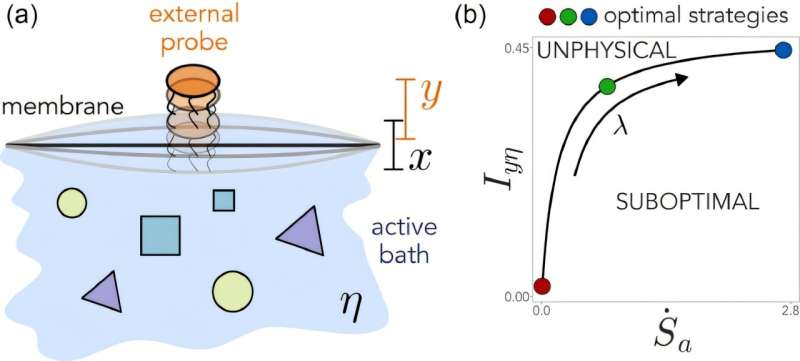To effectively adapt to change, living organisms rely on their ability to rapidly detect and process sensory information in their surroundings. The sensory information available at a given time continuously changes, which means that it can typically only be observed partially and for a limited amount of time.
Researchers at École Polytechnique Fédérale de Lausanne and Max Planck Institute for the Physics of Complex Systems recently carried out a theoretical study aimed at elucidating how biological systems convert information accessible at a given time into meaningful conclusions while spending a limited amount of energy.
Their paper, published in Physical Review Letters, suggests that optimal transduction strategies could boost information harvesting (i.e., the process through which living organisms gather vital information from their environment and use it to guide their behavior).
“Living organisms must sense and process information from the external world to survive, but they often cannot directly ‘listen’ to their surroundings,” Giorgio Nicoletti, co-author of the paper, told Phys.org. “Rather, they need to rely on what we call ‘transduction mechanisms’ that receive external signals and transmit them to their internal processes.
“We wanted to understand how well such mechanisms can convey information on hidden sources, especially with a limited energy budget—a crucial constraint for biological systems.”
The researchers devised a new theoretical framework and specifically applied it to the study of red blood cells. They focused on the potential role of these cells’ membrane, a semi-permeable barrier known to contribute to a cell’s survival and functions.
“Think of the membrane of red blood cells: in our framework, its role is to transduce information between the internal processes of the cell and the external world,” said Nicoletti. “Can we understand what is the optimal transduction strategy that the cell can choose to maximize information and minimize energy dissipation at the same time?”

The key objective of this recent study by Nicoletti and Daniel M. Busiello was to offer a theoretical explanation of how biological systems exploit the information available to them to derive vital data that can inform their actions in an energy efficient way. In their recent paper, they specifically used their framework to describe transduction processes in red blood cells, focusing on how these processes change in response to a cell’s activity.
“We were inspired by several models of the dynamics between the internal cytoskeleton of a red blood cell, the cell membrane, and the environment,” explained Nicoletti. “By studying these models in a general setting, we leveraged ideas from information theory, the theory of stochastic processes, and stochastic thermodynamics to explicitly characterize information and energy dissipation from a theoretical perspective.”
The researchers applied their theoretical framework to experimental data collected as part of a previous study featured in Science, which focused on the flickering of red blood cells. This flickering behavior consists in tiny spontaneous movements of the membrane surrounding red blood cells.
“We elucidated the key general mechanisms that allow biological systems to extract information from inaccessible variables in their surroundings in an energy-efficient way,” said Busiello. “In particular, we found that higher dissipation allows the system to capture more information from hidden observables, paving the way for a precise definition of a system’s strategy to process information.”
This recent paper by Nicoletti and Busiello introduces a valuable framework that could be used to better understand the processes linked to information harvesting in various biological systems. In the future, their framework could serve as a quantitative tool for designing optimal decoding strategies in artificial bio-inspired devices. In addition, it could help to shed light on how transduction strategies are implemented in practice in real-world scenarios.
“Biological and living systems operate through a set of complex interconnected processes. Bees, for example, communicate via a combination of chemical signaling through pheromones and wing movements, continuously dissipating energy,” added Busiello. “Future investigations in the field might focus on understanding how these intricate mechanisms are used to harvest information and mitigate, or even harness, the surrounding noise.”
More information:
Giorgio Nicoletti et al, Tuning Transduction from Hidden Observables to Optimize Information Harvesting, Physical Review Letters (2024). DOI: 10.1103/PhysRevLett.133.158401
© 2024 Science X Network
Citation:
Theoretical framework could improve data gathering in biological systems (2024, October 31)
retrieved 31 October 2024
from https://phys.org/news/2024-10-theoretical-framework-biological.html
This document is subject to copyright. Apart from any fair dealing for the purpose of private study or research, no
part may be reproduced without the written permission. The content is provided for information purposes only.

